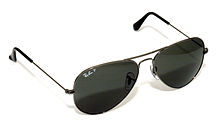Aviator sunglasses

Aviator sunglasses are a style of sunglasses that were developed by Bausch & Lomb. The original Bausch & Lomb design is now marketed as Ray-Ban Aviators, although other manufacturers also produce aviator style sunglasses.
Design
They are characterised by dark, often reflective lenses having an area two or three times the area of the eyeball, and very thin metal frames with double or triple bridge (so-called ″bullet hole″) and bayonet earpieces or flexible cable temples that hook behind the ears. The original design featured G-15 tempered glass lenses, transmitting 15% of incoming light. The large lenses are not flat but slightly convex. The design attempts to cover the entire range of the human eye and prevent as much light as possible from entering the eye from any angle.[1]
History

Aviator sunglasses, or "pilot's glasses", were originally developed in 1936 by Bausch & Lomb for pilots to protect their eyes while flying, thus the name aviator. This style of sunglasses is credited with being one the first popularized style of sunglasses to be developed.[4] In its military usage, the sunglasses replaced the outmoded flight goggles used previously, as they were designed to be lighter, thinner, and “more elegantly designed”. Writing about the transition of aviators from military gear to commercial product, Vanessa Brown wrote that, “The War was a … revelation of the sheer might, scale, power, and horror of the modern world … [which] necessitated a new kind of military demeanor and gave rise to new definitions of the heroic stance which was to have a profound influence on modern fashion.”[5] Eventually the aviator sunglasses produced by Bausch & Lomb were trademarked as “Ray Bans”.[6]
The Aviator became a well-known style of sunglasses when General Douglas MacArthur landed on a beach in the Philippines in World War II[7] and newspaper photographers snapped several pictures of him wearing them that became a lasting image of the Second World War.[8] Bausch & Lomb dedicated a line of sunglasses to him in 1987.[3]
Commercial designs
The first advertisements for Ray-Ban aviators stated they would provide “real scientific glare protection”, and were sold as sporting equipment. At this time they had not yet taking on their name of “aviators”, as the Second World War had not yet begun. In addition to popularity in the 1950s, aviators were popular in the 1970s, with colored frames, being worn by public figures like Elvis Presley.[9] During the 1950s, aviator sunglasses were a part of the cultural style, mimicking a military ethos.[10]
References
- ^ U.S. patent D292984
- ^ Gary S. Messinger: The battle for the mind – War and peace in the era of mass communication. University of Massachusetts Press, Amherst 2011, ISBN 978-1-55849-853-2. p. 131–132
- ^ a b Christopher Klein: 10 Things You May Not Know About Douglas MacArthur. On May 22, 2014 at history.com
- ^ Jr, Anthony Rubino (18 March 2010). "Why Didn't I Think of That?: 101 Inventions that Changed the World by Hardly Trying". Adams Media – via Google Books.
- ^ Brown, Vanessa (18 December 2014). "Cool Shades: The History and Meaning of Sunglasses". Bloomsbury Publishing – via Google Books.
- ^ Segrave, Kerry (23 March 2011). "Vision Aids in America: A Social History of Eyewear and Sight Correction Since 1900". McFarland – via Google Books.
- ^ Arthur Asa Berger: Media and communication research methods – An introduction to qualitative and quantitative approaches. Sage, Thousand Oaks 2011, ISBN 978-1-4129-8777-6. p. 66–67
- ^ "The Oxford Encyclopedia of American Military and Diplomatic History". OUP USA. 31 January 2013 – via Google Books.
- ^ "Who Made Those Aviator Sunglasses?". The New York Times. 5 August 2012.
- ^ Frum, David (1 January 2008). "How We Got Here: The 70s The Decade That Brought You Modern Life--For Better Or Worse". Basic Books – via Google Books.
